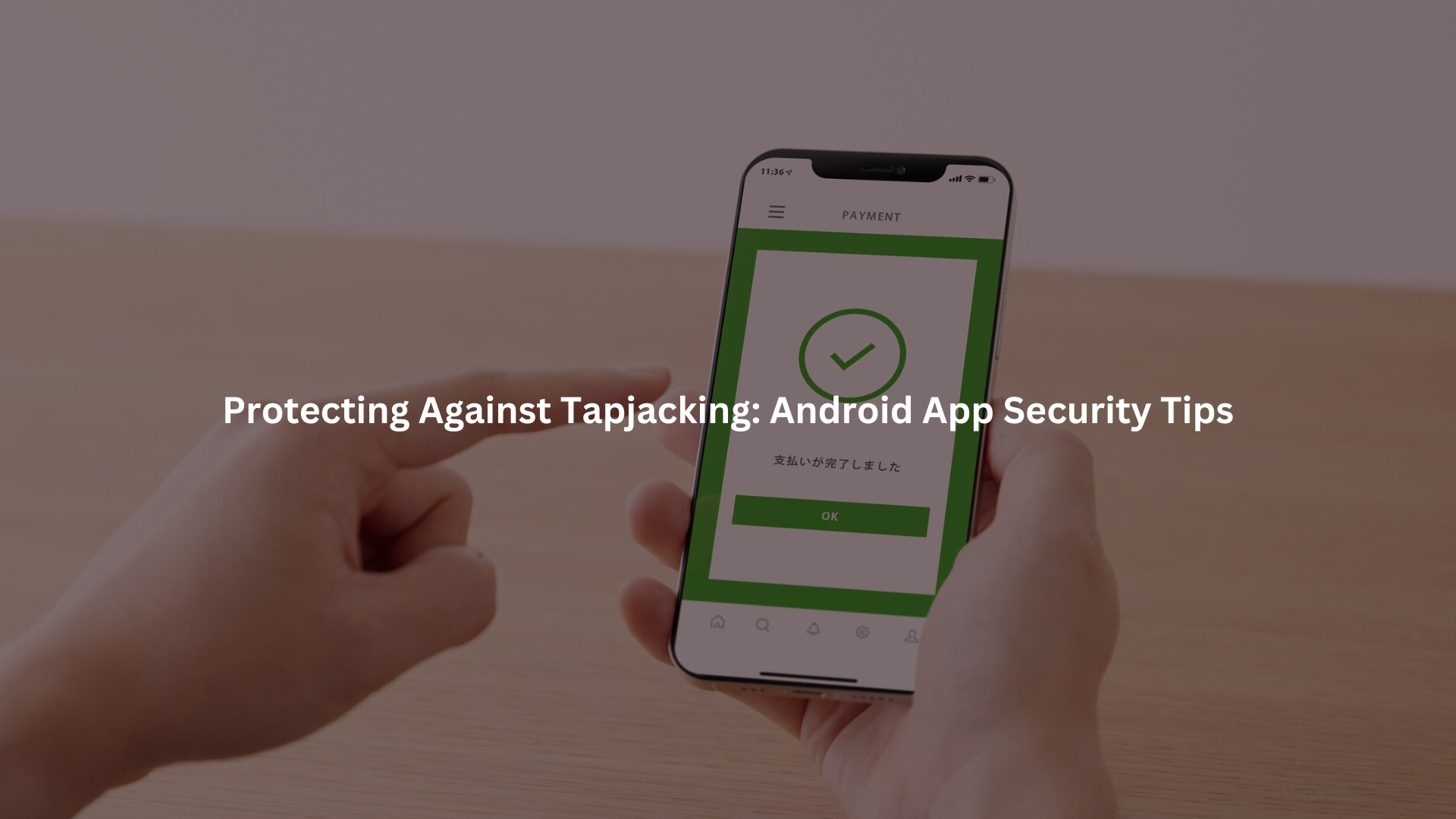
Use the right security tools and techniques to guard against tapjacking on Android. Apply touch filtering and window configuration to prevent malicious overlays. Keep both apps and users safe by staying alert to new threats and keeping everything updated.
Key Takeaways
- Apply Android’s built-in touch event filtering and window security flags on sensitive screens to block overlay attacks.
- Test, update, and reconfigure apps regularly to stay ahead of emerging tapjacking tricks like TapTrap.
- Educate users to help them spot suspicious apps and dialogs, reducing risky taps and permissions.
Android Security Mitigations Against Tapjacking
Before working in Android security, we didn’t think much about invisible threats. Tapjacking moves quietly, most users never realize their taps are being hijacked by something they cannot see.
The reality is, tapjacking is a type of UI redressing attack, where a malicious app overlays a transparent or misleading screen above a legitimate one. Users think they’re tapping a harmless button, but the real action is happening underneath, permission grants, unwanted app installs, or settings changes.
Android’s response is layered. There are preventive tools for both developers and users, but also new attack methods constantly surfacing. TapTrap, for example, sidesteps the old defenses by exploiting activity transition animations. Even zero-permission apps can exploit this on Android 15 and 16, making defensive coding more urgent. [1]
Android System-Level Protections
Android’s core security model tries to stop overlays from intercepting taps on sensitive UI elements. Early versions only addressed the most obvious overlays, but recent updates go further. Developers can set attributes or override methods to reject any touch event if their app detects it’s being obscured.
Our team uses these secure coding methods for mobile:
- android:filterTouchesWhenObscured
A single attribute, when set to true on a view, will instruct Android to ignore touches if that view is covered by another window. It’s simple and powerful on permission buttons or “Confirm” dialogs. - onFilterTouchEventForSecurity(MotionEvent ev)
For more control, developers can override this method. The view receives each touch event and can check if its window is obscured. This lets us build custom policies, maybe log suspicious events, or only reject when the button is high-risk.
Android’s documentation recommends using these features on any UI elements that could trigger sensitive actions, like accepting permissions or launching protected activities.
Window-Level Safeguards
Protecting the UI doesn’t stop at filtering individual touches. We’ve learned that window-level flags matter just as much. Malicious overlays succeed when sensitive content is visible to other apps or can be drawn over.
Here’s what we apply:
- FLAG_SECURE
Setting this flag on an activity or window tells Android not to allow screenshots, screen recordings, or overlays. That means other apps cannot display content on top, nor can they capture what’s underneath. It’s a must for anything handling confidential data, credentials, or sensitive settings. - Exported Activity Management
Activities marked as exported can be started from outside the app. We make sure sensitive activities are never exported unless there’s a business case. This closes a door to external launch attacks that might otherwise slip by unnoticed.
Animation and Activity Launch Controls
Animation can be fun, but we never thought of it as a security risk until TapTrap emerged. Now, it’s in our checklist.
- Transition Animation Controls
TapTrap abuses low-opacity activity transition animations to create nearly invisible prompts. By disabling or limiting these animations, the attack surface shrinks. We recommend providing users an option to turn off transitions, especially on devices where new Android versions might not be fully patched. - setShowWhenLocked(false)
Prevents apps from showing over the lock screen, which is another target for overlay or spoofing attacks. Secure activities should never appear above the lock screen unless absolutely necessary.
Platform Updates and User Awareness
Security isn’t just about coding, it’s also about what users do with their devices. Android updates frequently patch overlay vulnerabilities and introduce new mitigations, but users lag behind on updates.
We encourage:
- Keeping devices updated, as Google’s patches often address new vulnerabilities like TapTrap.
- Raising awareness: teach users to avoid installing suspicious apps and to be skeptical of unexpected permission dialogs.
Developer Best Practices for Tapjacking Mitigation
Credits: Philipp Lackner
We teach bootcamp participants that technical controls go hand-in-hand with good habits. Here’s what we follow and recommend. [2]
UI Design and Touch Event Handling
- Apply android:filterTouchesWhenObscured=”true” to all buttons that perform sensitive actions.
- Implement custom logic in onFilterTouchEventForSecurity to log or block touches when the view is partially or fully obscured.
- Regularly test touch event handling on different Android versions and screen sizes to follow secure Android coding habits from the start.
Activity and Window Configuration
- Audit all activities to avoid exporting those that handle sensitive data (android:exported=”false”).
- Use FLAG_SECURE on any screen that shows private information or financial transactions.
Testing and Maintenance
- Test apps on the latest Android versions, especially those known to be vulnerable to TapTrap.
- Provide users an option to disable UI animations via settings.
- Monitor security forums and bulletins for new overlay attack techniques, and patch apps quickly.
Staying Informed on Emerging Threats
The security landscape shifts. Our instructors keep tabs on new research, TapTrap is just the latest in a series of overlay attacks. We subscribe to Android security mailing lists, watch for advisories, and run internal threat modeling sessions every quarter.
Additional Considerations and Emerging Trends
Balancing User Experience and Security
There’s always tension between security and usability. Disabling animations or overlays can make an app feel less polished, or even confusing to some users. But the risk of invisible taps is real. We test changes with real users, gather feedback, and adjust, sometimes a small animation tweak is enough, rather than removing transitions entirely.
Integration with Broader Android Security Measures
No mitigation works in isolation. We combine tapjacking defenses with app hardening strategies:
- Use strict app permission models, don’t request more than needed, and prompt users only when necessary.
- Employ obfuscation and runtime verification to prevent reverse engineering of sensitive logic.
- Integrate tapjacking protections into a broader app security checklist, alongside encryption, secure Android data storage, and network protections.
Future Directions in Tapjacking Defense
Platform vendors are working on deeper changes, stricter animation management, smarter overlay detection, and potential use of machine learning to spot anomalous tap patterns.
We see promise in:
- Android OS improvements that restrict overlays and animations for sensitive activities by default.
- Behavioral analysis on-device, flagging or blocking touch patterns that don’t match typical user interaction (for example, perfectly timed, repeated taps in a straight line).
But until these changes are universal, it’s on developers like us to patch, test, and educate.
Practical Advice for Secure Android Development

Tapjacking is both simple and insidious. Developers have tools, android:filterTouchesWhenObscured, FLAG_SECURE, careful activity management, but must use them thoughtfully. Overlay attacks won’t disappear tomorrow, and new variants like TapTrap will keep surfacing.
Our advice for teams securing Android apps:
- Review your UI for risky buttons and dialogs, and apply touch filtering.
- Check which activities are exported, lock down those you don’t intend for outside use.
- Add FLAG_SECURE to all sensitive screens, not just payment or login.
- Build a habit of reading Android security bulletins every month.
- And most of all, talk to your users. Teach them to be careful with permissions and skeptical of odd-looking dialogs.
FAQ
How can filterTouchesWhenObscured be used to block touch event hijacking from malicious overlays?
Some Android apps don’t notice when another app lays over them. Tapjacking attacks use this by showing fake screens over real buttons. When users tap, they’re really tapping hidden controls. The filterTouchesWhenObscured setting tells Android to ignore taps if something covers the app. It stops touch event hijacking, which is part of securing UI redressing and overlay attack Android defense.
What’s the risk of partial occlusion attacks versus full occlusion in Android UI overlays?
A full occlusion hides the whole screen, more obvious to a user. But partial occlusion attacks are harder to spot. These attacks place a small overlay (like a fake button or image) that fools users into clicking the wrong thing. This leads to user consent bypass, app permission spoofing, or triggering system dialog attacks. Android security mitigation should cover both types in UI touch event filtering logic.
Why should FLAG_SECURE and other Android secure flags be standard in secure activity design?
FLAG_SECURE blocks screenshots and screen recordings, but it also helps fight UI redressing attacks by preventing overlays in some cases. When building a secure Android UI, combining secure flags with proper Android permission security policies reduces the risk of overlay attack Android exploits. These small flags play a big role in Android app hardening and protecting against malicious app overlay threats.
How do zero permission attacks bypass Android permissions security during a tapjacking attack?
Tapjacking doesn’t always need permissions. With a clever use of Android UI overlays and animation tricks (such as those seen in the TapTrap vulnerability), malicious apps can trick users without ever asking for access. This makes Android developer security harder. Developers must use app security testing tools to simulate zero permission attacks and adjust touch interception settings or apply Android secure flags.
What role does activity launch security play in preventing TapTrap-style Android animation attacks?
Some malicious UI protection failures start with exported activities that accept outside input without checks. If a malicious app launches an activity using intent tricks, combined with Android animation attack methods, it can lead to tapjacking or permission trick scenarios. Locking down exported activities is key to activity launch security. Combine that with Android security frameworks and app security code reviews for proper defense.
Conclusion
Security isn’t a one-time fix. It’s a habit, a discipline, and a community effort. For those learning secure development with us, tapjacking defense is just the start. Stay curious, keep testing, and remember: invisible threats require visible action.
If you’re serious about securing your Android apps, join the Secure Coding Practices Bootcamp and learn how to build safer code through hands-on, real-world sessions, no fluff, just what developers need.
References
- https://www.researchgate.net/publication/311574084_Tapjacking_Threats_and_Mitigation_Techniques_for_Android_Applications
- https://developer.android.com/privacy-and-security/risks/tapjacking

